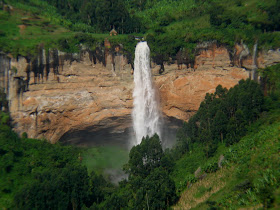Mount Elgon is an extinct shield volcano on the border of Uganda and Kenya, north of Kisumu and west of Kitale.
Physical features
Other features of note are:
- The caldera — Elgon's is one of the largest intact calderas in the world
- The warm springs by the Suam River
- Endebess Bluff (2563m or 8408 ft)
- Ngwarisha, Makingeny, Chepnyalil and Kitum caves. Kitum Cave is over 60 metres wide and penetrates 200 metres. It is frequented by wild elephants who lick the salt exposed by gouging the walls with their tusks. It became notorious following the publication of Richard Preston's book The Hot Zone in 1994 for its association with the Marburg virus after two people who had visited the cave (one in 1980 and another in 1987) contracted the disease and died.
The mountain soils are red laterite. The mountain is the catchment area for the several rivers such as the Suam River which becomes the Turkwel downstream and which drains into Lake Turkana, the Nzoia River and the Lwakhakha which flow to Lake Victoria. The town of Kitale is in the foothills of the mountain. The area around the mountain is protected by two Mount Elgon National Parks one on each side of the international border.
Some rare plants are found on the mountain, including Ardisiandra wettsteinii, Carduus afromontanus, Echinops hoehnelii, Ranunculus keniensis, and Romulea keniensis.
In 1896, C. W. Hobley became the first European to circumnavigate the mountain. Kmunke and Stigler made the first recorded ascent of Wagagai and Koitobos in 1911. F. Jackson, E. Gedge, and J. Martin made the first recorded ascent of Sudek in 1890. The main peak is an easy scramble and does not require any special mountaineering skills.




No comments:
Post a Comment